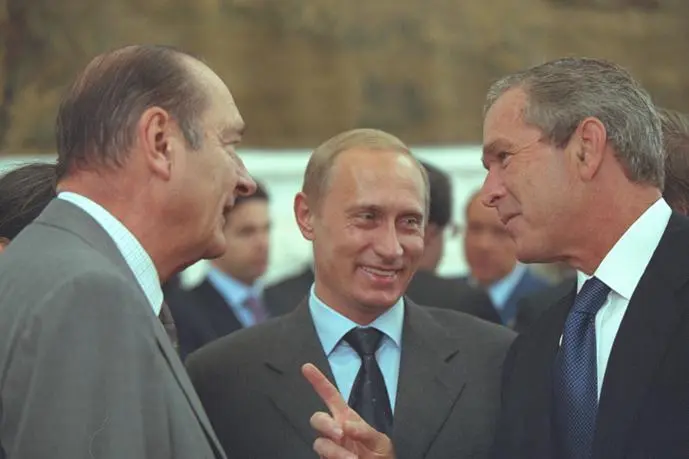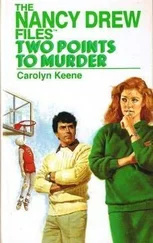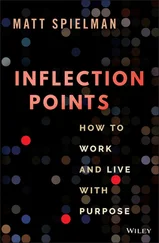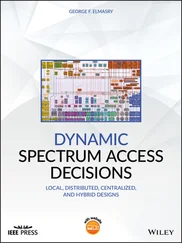If we had to remove Saddam from power, Tony and I would have an obligation to help the Iraqi people replace Saddam’s tyranny with a democracy. The transformation would have an impact beyond Iraq’s borders. The Middle East was the center of a global ideological struggle. On one side were decent people who wanted to live in dignity and peace. On the other were extremists who sought to impose their radical views through violence and intimidation. They exploited conditions of hopelessness and repression to recruit and spread their ideology. The best way to protect our countries in the long run was to counter their dark vision with a more compelling alternative.
That alternative was freedom. People who could choose their leaders at the ballot box would be less likely to turn to violence. Young people growing up with hope in the future would not search for meaning in the ideology of terror. Once liberty took root in one society, it could spread to others.
In April 2002, Tony and Cherie visited Laura and me in Crawford. Tony and I talked about coercive diplomacy as a way to address the threat from Iraq. Tony suggested that we seek a UN Security Council resolution that presented Saddam with a clear ultimatum: allow weapons inspectors back into Iraq, or face serious consequences. I didn’t have a lot of faith in the UN. The Security Council had passed sixteen resolutions against Saddam to no avail. But I agreed to consider his idea.

I raised Iraq with other world leaders throughout 2002. Many shared my assessment of the threat, including John Howard of Australia, José Maria Aznar of Spain, Junichiro Koizumi of Japan, Jan Peter Balkenende of the Netherlands, Anders Fogh Rasmussen of Denmark, Aleksander Kwasniewski of Poland, and most other leaders in Central and Eastern Europe. It was revealing that some of the strongest advocates for confronting Saddam were those with the freshest memories of tyranny. “In the late 1930s, the Western democracies hesitated in the face of danger,” Prime Minister Siim Kallas of Estonia, a former Soviet republic, told me. “As a consequence, we fell under dictatorships and many people lost their lives. Action is sometimes necessary.”
Other leaders had a different outlook. Vladimir Putin didn’t consider Saddam a threat. It seemed to me that part of the reason was Putin didn’t want to jeopardize Russia’s lucrative oil contracts. France also had significant economic interests in Iraq. I was not surprised when Jacques Chirac told me he would support intrusive weapons inspections but cautioned against threatening military force. The problem with his logic was that without a credible threat of force, the diplomacy would be toothless once again.

With Jacques Chirac ( left ) and Vladimir Putin. White House/Eric Draper
One of the toughest leaders to figure out was Chancellor Gerhard Schroeder of Germany. I met with Gerhard five times in 2001. He was relaxed, affable, and interested in strengthening our bilateral relationship. I appreciated his leadership on Afghanistan, especially his willingness to host the loya jirga in Bonn.
I discussed Iraq with Gerhard during his visit to the White House on January 31, 2002. In my State of the Union address two days earlier, I had outlined the threats posed by Iraq, Iran, and North Korea. “States like these, and their terrorist allies, constitute an axis of evil, arming to threaten the peace of the world,” I said. The media seized on the phrase “axis of evil.” They took the line to mean that the three countries had formed an alliance. That missed the point. The axis I referred to was the link between the governments that pursued WMD and the terrorists who could use those weapons. There was a larger point in the speech that no one could miss: I was serious about dealing with Iraq.
In a small Oval Office meeting, joined by Condi Rice and Andy Card, I told the German chancellor I was determined to make diplomacy work. I hoped he would help. I also assured him our words would not be empty. The military option was my last choice, but I would use it if necessary.
“What is true of Afghanistan is true of Iraq,” he said. “Nations that sponsor terror must face consequences. If you make it fast and make it decisive, I will be with you.”
I took that as a statement of support. But when the German elections arrived later that year, Schroeder had a different take. He denounced the possibility of using force against Iraq. His justice minister said, “Bush wants to divert attention from domestic political problems. … Hitler also did that.” I was shocked and furious. It was hard to think of anything more insulting than being compared to Hitler by a German official. I continued to work with Gerhard Schroeder on areas of mutual interest. But as someone who valued personal diplomacy, I put a high premium on trust. Once that trust was violated, it was hard to have a constructive relationship again.

Two months after 9/11, I asked Don Rumsfeld to review the existing battle plans for Iraq. We needed to develop the coercive half of coercive diplomacy.
Don tasked General Tommy Franks with updating the plans. Just after Christmas 2001, Tommy came to Crawford to brief me on Iraq. The plan on the shelf required a six-month buildup and four hundred thousand troops. The experience in Afghanistan was at the forefront of our minds. Thanks to new technology and innovative planning, we had destroyed the Taliban and closed the al Qaeda camps using far fewer troops. We were not viewed as occupiers by the Afghan people.
Tommy told the national security team that he was working to apply the same concept of a light footprint to Iraq. He envisioned a fast invasion from Kuwait in the south, Saudi Arabia and Jordan in the west, and Turkey in the north. “If we have multiple, highly skilled Special Operations Forces identifying targets for precision-guided munitions, we will need fewer conventional ground forces,” he said. “That’s an important lesson learned from Afghanistan.”
I had a lot of concerns. I wanted to know how fast our troops could move and what kind of basing we would need. As in Afghanistan, I was concerned about starvation of the local population and asked what we could do to protect innocent life. I worried about Saddam sabotaging the oil fields or firing missiles at Israel. My biggest fear was that he would use biological or chemical weapons against our troops, our allies, or Iraqi civilians.
I asked the team to keep working on the plan. “We should remain optimistic that diplomacy and international pressure will succeed in disarming the regime,” I said at the end of the meeting. “But we cannot allow weapons of mass destruction to fall into the hands of terrorists. I will not allow that to happen.”

Between December 2001 and August 2002, I met or spoke with Tommy more than a dozen times. The plan was getting better, but I wasn’t satisfied. I wanted to make sure we had thought through as many contingencies as possible. I asked Don and Tommy a lot of questions that started with “What if Saddam decides to … ?” One scenario I brought up frequently was Saddam consolidating his forces in Baghdad and engaging our troops in bloody urban combat. I remembered the battle in Somalia in 1993 and did not want to see that repeated in Iraq. Tommy and his team didn’t have all the answers on the spot, and I didn’t expect them to. But they were working hard to refine the plan, and every iteration they brought me was an improvement on the previous version.
Читать дальше













